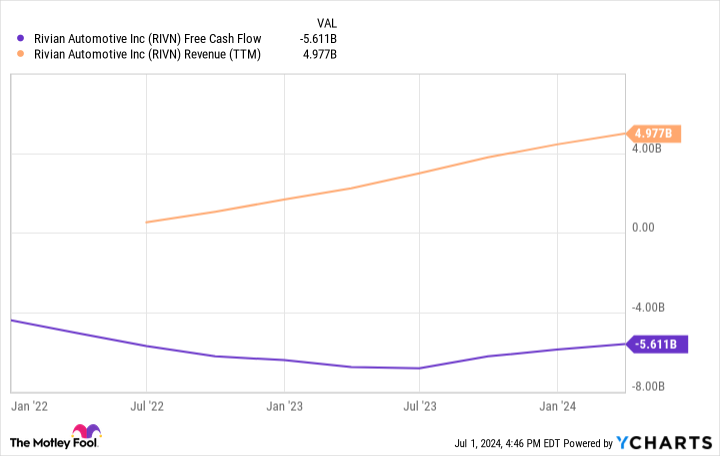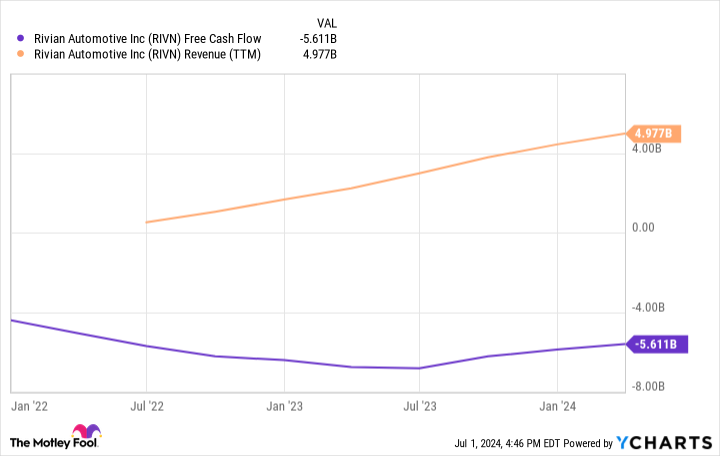Last month, we got a massive shake-up in the electric vehicle (EV) industry. Rivian Automotive (NASDAQ: RIVN) — one of the most successful EV brands besides Tesla — inked a $5 billion deal with Volkswagen to fund future growth and build a software/technology joint venture group. Rivian stock shot up over 30% on the news and is now up 27% in the past month.
This deal is huge for Rivian. Burning a ton of cash and running out of money from its initial public offering (IPO), Rivian can utilize this funding to further scale its operations and hopefully reach positive cash flow.
Here’s the skinny on the deal and what comes next for the EV stock.
Volkswagen deal: $5 billion capital cushion
The $5 billion deal with Volkswagen comes with multiple steps. There is an initial investment of $1 billion, and then $4 billion coming over the next two years. In addition, $2 billion of future investment will be in Rivian equity (i.e., common stock), while $2 billion from Volkswagen will contribute to the newly formed joint venture group.
At the end of Q1, Rivian had a cash balance of $7.9 billion. While this seems like a lot, the company is burning $5.6 billion a year in free cash flow. This new funding extends Rivian’s timeline for achieving profitability, which will likely take multiple years, given that the brand is still subscale (it only expects to produce 57,000 vehicles this year).
The deal not only gives Rivian a cash cushion, but also a huge partner to deploy its advanced vehicle software and technology to. According to the announcement, Volkswagen is planning to deploy Rivian’s electronic hardware and software systems for its future vehicles beginning in the second half of this decade. This will help Rivian further scale its operations and bring in more revenue over its fixed-cost investments, hopefully leading to operating leverage on the income statement.
Can Rivian reach positive cash flow?
Rivian is burning a ton of cash. It lost $5.6 billion in free cash flow over the last 12 months on just $5 billion in sales. Clearly, it needs to scale its EV manufacturing in order to stem this burn and eventually reach positive cash flow. Otherwise, the stock will not be worth much.
At its recent Investor Day, management stated that it can reach annual production of 150,000 vehicles on its current operations. Then, it plans to reach 215,000 with the addition of the new vehicle called the R2, and eventually another 400,000 more in capacity from future vehicles called the R3 and R3X. This would bring annual production from 57,000 today to over 600,000 within just a few years, a 10x in volume growth.
If/when this happens, Rivian believes it can consistently bring down its unit costs. The plan is for a 20% cost reduction for the second generation of its first vehicle, called the R1, and then a further 45% cost reduction on the R2. With gross margins of -44% today, it is imperative for the company to achieve these cost cuts. Right now, its unit economics are unsustainable.
What comes next?
In the near term, there are two things Rivian investors need to watch: production volume and gross margins. Both are related for a car manufacturer, and will need to improve in the coming years in order to stem the current unsustainable cash burn.
Over the coming three to five years, Rivian will need to increase its deliveries to hit its planned production capacity of 600,000 vehicles. More scale along with cost cuts on a per-unit basis can help gross margins move from -45% to 25%, management’s stated long-term goal.
Over the long term, investors need to be tracking whether Rivian hits its long-term target of a 10% free cash flow margin. If they hit this estimate while growing production volumes by 10x, the stock will likely do well for investors who buy today. If they keep burning cash forever, the stock will not be worth much, though.
Should you invest $1,000 in Rivian Automotive right now?
Before you buy stock in Rivian Automotive, consider this:
The Motley Fool Stock Advisor analyst team just identified what they believe are the 10 best stocks for investors to buy now… and Rivian Automotive wasn’t one of them. The 10 stocks that made the cut could produce monster returns in the coming years.
Consider when Nvidia made this list on April 15, 2005… if you invested $1,000 at the time of our recommendation, you’d have $751,670!*
Stock Advisor provides investors with an easy-to-follow blueprint for success, including guidance on building a portfolio, regular updates from analysts, and two new stock picks each month. The Stock Advisor service has more than quadrupled the return of S&P 500 since 2002*.
*Stock Advisor returns as of July 2, 2024
Brett Schafer has no position in any of the stocks mentioned. The Motley Fool has positions in and recommends Tesla and Volkswagen Ag. The Motley Fool has a disclosure policy.
Huge News for Rivian Stock: Here’s What Comes Next was originally published by The Motley Fool
EMEA Tribune is not involved in this news article, it is taken from our partners and or from the News Agencies. Copyright and Credit go to the News Agencies, email news@emeatribune.com Follow our WhatsApp verified Channel






